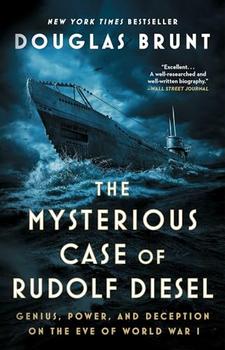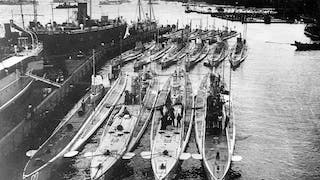Summary | Excerpt | Reviews | Beyond the Book | Read-Alikes | Genres & Themes | Author Bio

Genius, Power, and Deception on the Eve of World War I
by Douglas BruntThis article relates to The Mysterious Case of Rudolf Diesel
 Douglas Brunt’s The Mysterious Case of Rudolf Diesel tells the story of Rudolf Diesel, the German inventor of the internal combustion engine. After the Industrial Revolution, industry had become king, and Diesel’s groundbreaking invention produced more power, used cheaper fuel and didn’t require a team of laborers to keep running. The railroad industry immediately adopted the diesel engines, but its use in naval vessels also played a key role in the tension between European nations—particularly Germany and Britain—that eventually erupted into World War I.
Douglas Brunt’s The Mysterious Case of Rudolf Diesel tells the story of Rudolf Diesel, the German inventor of the internal combustion engine. After the Industrial Revolution, industry had become king, and Diesel’s groundbreaking invention produced more power, used cheaper fuel and didn’t require a team of laborers to keep running. The railroad industry immediately adopted the diesel engines, but its use in naval vessels also played a key role in the tension between European nations—particularly Germany and Britain—that eventually erupted into World War I.
Prior to WWI, Germany had a weak navy, especially compared to Britain's. Despite a massive naval expansion, Germany still failed to compete with the Royal Navy and instead began focusing on another type of vessel: submarines. Called U-boats or unterseeboots in German, this type of underwater ship had been previously built and utilized, most famously by the Confederacy during the American Civil War with the H.L. Hunley, but the invention of the diesel engine allowed the Germans to build a far more powerful squadron.
Germany began the war with a squadron of 20 U-boats containing diesel engines developed by Maschinenfabrik Augsburg-Nürnberg, an engineering company based in Munich. Unlike their predecessors, these U-boats were sharks in the water: they could dive to depths up to 50m, move as fast as 9 mph underwater, stay underwater for up to 2 hours at a time, and travel as far as 5,000 miles before stopping to refuel. They were armed with deck-mounted guns and more than a dozen self-propelled torpedoes. And they couldn’t be detected by surface ships, thanks to their steamless, smokeless diesel engines, making U-boats a true threat against Allied ships.
U-boats first followed prize law, which stated that they had to give sailors and passengers the opportunity to escape before destroying a vessel. Attacks, which began in late 1914, initially focused on merchant ships. The British naval blockade of Germany, however, soon led to massive food shortages, and in retaliation, Germany began unrestricted submarine warfare in early 1915. Under this new campaign, U-boats would attack without warning, not only destroying cargo but taking lives as well. Many nations saw these attacks as criminal—Britain claimed they were illegal acts of piracy—but it wasn’t until May 1915, when a U-boat sunk the British passenger ship Lusitania, killing more than 1,000 passengers and crew, that Germany returned to prize law.
1917, however, saw U-boats resuming their unrestricted attacks, finally prompting several neutral countries, including the United States, to join the war. As attacks continued, the Allies began to send merchant and passenger ships with military escorts who could retaliate against the U-boats; these convoys finally deterred Germany’s aggressive campaign. Nonetheless, by the end of the war, U-boats had sunk almost 5,000 merchant ships, destroyed 10 million tons of cargo, and killed approximately 15,000 people. They had traveled as far as the East Coast of the United States and had even sunk 10 ships off the coast of North Carolina.
The 1919 Treaty of Versailles required the Germans to surrender their remaining U-boats to Allied nations. Commander Holbrook C. Gibson of the United States Navy had the opportunity to study several U-boat engines and declared that “the Germans have done things that we [Americans] have not done.” According to Gibson, the U-boats' diesel engines ran smoother and cleaner than anything America had produced, and the German engineers had solved several issues that had plagued American developers. Gibson further stated that the Germans “did things with steel piping which [American engineers] do not yet know how to do” and concluded that the United States Navy needed to take note of the Germans' work to build better versions of the diesel engine for their own submarines.
The invention and implementation of the diesel engine in German U-boats transformed a poor technology into a true threat during WWI. Although Diesel himself wanted his engine to be used for altruistic purposes, the political climate of the time, as outlined in The Mysterious Case of Rudolf Diesel, sadly led to more destructive uses, none more so than in the deadly German U-boats.
WWI German submarines in harbor, courtesy of National Museum of the U.S. Navy
Filed under Medicine, Science and Tech
![]() This "beyond the book article" relates to The Mysterious Case of Rudolf Diesel. It originally ran in September 2023 and has been updated for the
October 2024 paperback edition.
Go to magazine.
This "beyond the book article" relates to The Mysterious Case of Rudolf Diesel. It originally ran in September 2023 and has been updated for the
October 2024 paperback edition.
Go to magazine.
Your guide toexceptional books
BookBrowse seeks out and recommends the best in contemporary fiction and nonfiction—books that not only engage and entertain but also deepen our understanding of ourselves and the world around us.